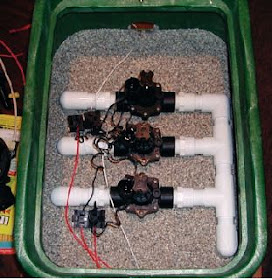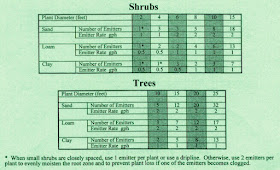Q. Some advice on watering
please. This is my first Las Vegas summer in a new to us house about 12 years
old. Lots of lantana, Texas rangers, bottle brush, small short palms and other
desert shrubs. Everything is on a drip
systems, no lawn. I am not sure how
often, how long to water. How many days,
once or twice a day, how long each time. My drip are adjustable.
Remember there are two types of overwatering: watering too often and
watering using too many minutes. It is far worse to overwater the first way than the second.
 |
| Valve box with valves |
A. There are 3 things you
need to know to use any irrigation clock or controller; the time of day to
water, the days during the week to water and the number of minutes to enter for
each station or valve.
 |
| Irrigation controller or timer. Three pieces of information are entered: days of the week on or off, how many minutes to run each valve and the time they begin. |
Most drip irrigation systems are a mess because the person
who installed them didn't know what they were doing or, if they did, they have
been altered over the years by landscape maintenance companies or the owner.
You have what you have... unless you are willing to go in and totally redo the
system ....which most people aren't.
Your irrigation clock
requires you to set each irrigation valve separately. Your irrigation system
might have lots of different plants on the same irrigation valve. That's very
common. If that's the case, you have to find a happy medium for everything on
that valve or redo the irrigation system. Most plants are quite adaptable to an
irrigation schedule. The biggest plant problems occur when homeowners water
daily on everything either because they are lazy or nothing seems to work for
them.
 |
| Irrigation emitters, drippers, should be distributed under the canopy of a plant to supply their roots with water. Lots of emitters are needed to keep large trees upright so they don't fall over. |
Time of day. If any part
of your irrigation system sprays or "sprinkles" water into the air
where the wind can move it around, this should be set for early in the morning
and end by sunrise. If it's drip irrigation, it can be done anytime but is usually
best if it comes on during the day as it is getting warm and, if a 2nd
irrigation is needed that day, to come on late in the afternoon or early
evening.
Days of the week. The days
of the week depends on how shallow or deep the roots of plants are growing.
Shallow rooted: lawns,
vegetables, annual flowers. Daily when it's hot. Vegetables and annual flowers
might require a 2nd irrigation later in the day on days it's really hot and
windy. Lawns should never require a 2nd irrigation on the same day. If they do,
then they should be aerated with a lawn aerator and encouraged to grow their
roots deeper.
Rooted to a medium depth:
woody shrubs up to 3 to 4 feet tall, woody vines and woody groundcovers.
Examples might include roses, lantana, mock orange, etc. Every other day to
every 3rd day when it is hot. When it is really hot you might have to irrigate
every other day but try to avoid watering daily if possible. Under some
circumstances, you might find it necessary.
Deep rooted trees and
shrubs: These are trees and large shrubs that provide shade or beauty. Whenever
possible, trees and shrubs that originate from desert climates should be on a
separate valve. This almost never happens. Examples include Mulberry, Olive,
ash trees, Purple leaf Plum, Fruit trees, etc. Once or twice a week during the
heat of the summer. In some cases, 3 times a week. When fruit trees are
producing fruit they should not be water stressed and require an extra
irrigation per week when fruit is being produced. Most landscape trees and
shrubs can be water stressed a little bit between irrigations.
Desert trees and shrubs:
In an ideal world these should be on a separate irrigation valve but that may
happen one out of every 20,000 homes. Examples include Palo Verde, Mesquite,
Texas rangers, Texas ebony, cacti but usually not most succulents like aloe and
the like. These plans can be irrigated less often than non-desert plants. The
volume of water applied to them may be the same as above but more days between
irrigations. During the summer they might be irrigated once every 7 to 10 days
for instance.
How many minutes for each
station = valve. Somehow you have to translate minutes to a volume of water.
Also, the volume of water delivered to each plant is dictated by the number and
size (gallons per hour) of the drip emitters.
Here are some general guidelines.
1. Each plant should have
a minimum of 2 drip emitters in case one of them fails.
2. Larger plants require
more drip emitters. The smallest plants require two drip emitters. Medium-sized
plants require four drip emitters. Larger plants/shrubs require 6 - 8 drip
emitters. Trees may require 10 – 20 or more drip emitters depending on their
size. If other plants are planted close to trees, under their canopy, the trees
will require fewer drip emitters because trees are "drinking" from
these other emitters.
3. Wet at least half of
the area under the canopy of trees and shrubs.
The number of minutes
should be enough for water to penetrate at least 18 inches deep in the soil
next to the emitters used for large trees and shrubs. For small and medium shrubs, vines and
groundcoveres, 12 inches is deep enough.






This topic can never be brought up too much or in too many ways. The chart is a good, basic summary which I'll have to use.
ReplyDelete